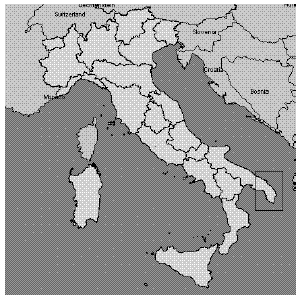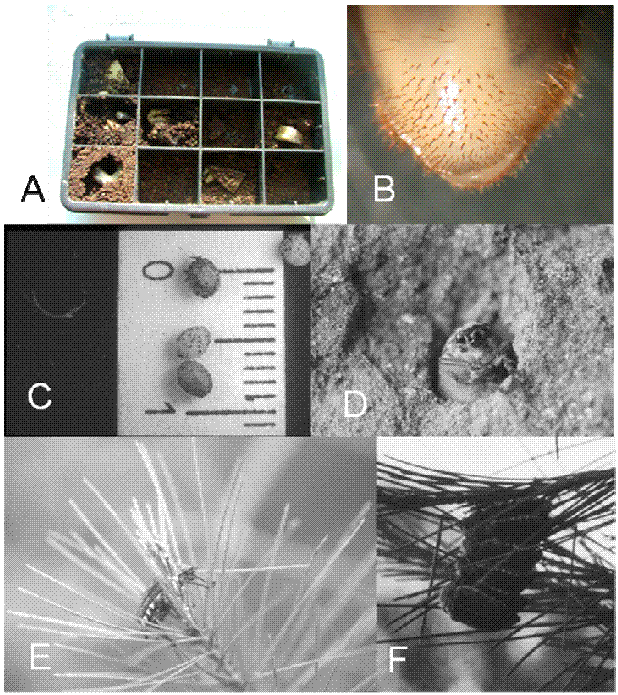Serviços Personalizados
Journal
Artigo
Indicadores
-
 Citado por SciELO
Citado por SciELO -
 Acessos
Acessos
Links relacionados
-
 Similares em
SciELO
Similares em
SciELO
Compartilhar
Silva Lusitana
versão impressa ISSN 0870-6352
Silva Lus. vol.19 n.Especial Lisboa 2011
Biological and Morphological Aspects of Anoxia (Mesanoxia) matutinalis ssp. matutinalis Castelnau, 1832 (Coleoptera, Melolonthidae), a Pest of Apulian Pinewoods in Southern Italy
Eustachio Tarasco and Oreste Triggiani
Department of Biology and Agro-Forestry and Environmental. Chemistry. Sec. Entomology and Zoology. University of Bari, Via Amendola 165/A, Bari, ITALY
Abstract
Huge defoliations by Anoxia (Mesanoxia) matutinalis spp. matutinalis Castelnau, 1832 (Coleoptera, Scarabeidae) have been observed in recent years in the coastal pinewoods (Pinus halepensis, P. pinea) of the southern Apulia Region of Italy. Starting from adults collected in the field, insect breeding was conducted in the laboratory, following the life-cycle from ovideposition to larval development and emergence. Observations were performed in the laboratory and the field to study the different morphological, biological and ethological aspects of A. matutinalis.
Key words: Pinus; pest; ethology; scarab beetle
Aspetos da Biologia e Morfologia da Anoxia (Mesanoxia) matutinalis ssp. matutinalis Castelnau, 1832 (Coleoptera, Melolonthidae), Praga nos Pinhais da Apúlia, Sul de Itália
Sumário
Desfolhas intensas causadas por Anoxia (Mesanoxia) matutinalis spp. matutinalis Castelnau, 1832 (Coleoptera, Scarabeidae) têm sido observadas nos últimos anos em pinhais costeiros de Pinus halepensis e P. pinea no Sul de Apúlia, Itália. Foi feita a recolha de adultos no terreno para manutenção de uma população em laboratório, tendo-se completado o ciclo de vida desde a postura, desenvolvimento larvar e emergência dos adultos em condições controladas. Tanto em laboratório como no terreno foram efetuadas observações de aspetos variados da morfologia, biologia e etologia de A. matutinalis.
Palavras-chave: Pinus; praga; etologia; escarabídeo
Introduction
Intensive defoliations caused by Anoxia (Mesanoxia) matutinalis spp. matutinalis Castelnau, 1832 (Coleoptera, Scarabeidae) have been observed in recent years in the coastal pinewoods of the southern Apulia Region, near the town of Otranto (Figure 1). The genus Anoxia includes more than 20 species with morphological differences mainly concerning clipeus, edeagus and larval pygidium; moreover, males and females present morphological differences in the legs and antennae (GRANDI, 1925).

Figure 1 - Map of Italy with area of surveys in south Apulia
The species Anoxia (M.) matutinalis has 5 subspecies: A. (M.) matutinalis spp. matutinalis Castenlau, 1832, reported in Italy, Croatia, Slovenia and Dalmatia; A. (M.) matutinalis spp. corsicana Sabatinelli, 1976, reported in Corsica; A. (M.) matutinalis spp. sardoa Motschulsky, 1861, reported in Sardinia; A. (M.) matutinalis spp. moltonii, Sabatinelli, 1976, reported on Vulcano island and A. (M.) matutinalis spp. suturalis Reitter, 1890, reported from Greece (SABATINELLI and SCHEMBRI, 1990). The Anoxia spp. found in the southern Apulian pinewoods belongs to the subspecies A. matutinalis matutinalis; the data on this Anoxia subspecies are quite scarce and fragmented. Studies were carried out to contribute to the knowledge of morphological, biological and ethological aspects of this insect.
Materials and methods
Starting from adults collected in the field, insect breeding was conducted in the laboratory to follow the life-cycle from ovideposition to larval development and emergence. A total of 30 plastic boxes (18x12x3 cm) with 12 small square cells (4x3.5x3 cm) per box were used (Figure 2A); a single egg was placed in each cell and covered with 5g of sterilized peat. The boxes were kept in the dark, at 24°C with an rh of 70%. Growing larvae were nourished with small pieces of potatos. Observations were performed in the laboratory and field to collect data on different morphological and biological aspects of A. matutinalis.

Figure 2 - Anoxia matutinalis: breeding box (A); larval pygidium (B); eggs (C); adult emergence (D) and feeding (E); adult pile (F)
Results and discussion
The adults of A. matutinalis measured 20-25 mm in length. They were characterized by evident chromatic variability, from light yellow to brown and may be classified according to 3 major chromatic groups with intermediate forms. Males and females presented differences in antennae and anterior legs; the female was usually bigger than the male. The eggs were round with a diameter of about 2.5 mm (Figure 2C). The larvae were yellowish, and possessed the characteristic morphology of the scarab beetle; their pygidium presented long hairs (Figure 2B).
Adults emerged (Figure 2D) in massive numbers from the soil of pinewoods or nearby cultivated and uncultivated fields at the end of May—beginning of June and migrated directly to the pine needles (Pinus halepensis Miller, P. Pinea Linnaeus). The emerging holes were 0.7-1.0 cm wide. Defoliation began with young and fresh leaves on which the adult beetle feeds by grasping the pine needles with its anterior legs (Figure 2E). The adults became very active in the late afternoon and could remain on the plants forming piles of 2 to 7 individuals (Figure 2F). After mating, females laid eggs in the soil which hatched after 3 weeks. Larvae fed on the roots and reached maturity in 2 years after 3 stages.
During our surveys no natural enemies of A. matutinalis were found, except for a few larvae infected by the entomopathogenic fungus Metarhizium anisopliae (Metschinkoff) Sorokin. Numerous phoretic Gamasida mites belonging to the species Coleolaelaps inopinatus Grandi were observed under the elytra of most individuals.
References
GRANDI, G., 1925.Contributo alla conoscenza dei lamellicorni fillofagi. III – Anoxia matutinalis Lap. V. suturalis Reitt. - Boll. Lab. Zool. Portici 18: 196-213. [ Links ]
SABATINELLI, G., SCHEMBRI, S., 1990. Gli scarabeidi floricoli delle isole maltesi. - Boll. Soc. ent. Ital., Genova 122(1): 31-36. [ Links ]













